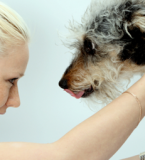Breast Cancer
Breast cancer is a cancer of the mammary glands. The average cat or dog has anywhere from eight to 10 mammary glands along the ventral portion of the abdomen. These paired mammary glands function to provide milk to pups and kittens. The basic anatomy of the teat or breast consists of the nipple, the areola, the ducts, the lobes, fatty tissues, the pectoral muscle, and the chest wall. The areola is the circle surrounding the nipple, usually slightly darker in color than the surrounding skin. The ducts are tubes through which milk travels from the lobes, the storage units. Fatty tissues surround the lobes as a protective cushion for the important internal structures. Behind the breast lies the pectoral muscles, which is more prevalent in the male, and the chest wall.
Breast cancer tends to affect unspayed females more than spayed females. Though the reason for cancer development is unknown, veterinary medical professionals have hypothesised a link between hormone production and tumors. There are four stages in the heat cycle of a dog or cat: proestrus, estrus, diestrus, and anestrous. It is believed that tumors develop between proestrus and estrus.






